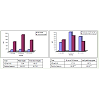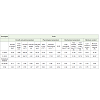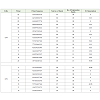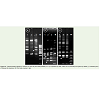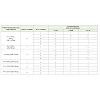Molecular Markers to Assess the Hybrid Nature of an Improved Mulberry Genotype
Vivek Arora1, M K Ghosh2, P K Ghosh2, S Nirmal Kumar2 and Gaurab Gangopadhyay1*
Corresponding author: Dr. Gaurab Gangopadhyay, Division of Plant Biology, Bose Institute, Kolkata- 700009, Tel.: +91 03323031124, Fax: +91 033 23506790, India, E-mail: gaurab@jcbose.ac.in
1Division of Plant Biology, Bose Institute, 93/1 APC Road, Kolkata - 700009, India
2Central Sericultural Research & Training Institute, Berhampore-742101, India
Citation: Citation: Arora V, Ghosh MK, Ghosh PK, Kumar SN, Gangopadhyay G. Molecular Markers to Assess the Hybrid Nature of an Improved Mulberry Genotype. J Plant Sci Res. 2015;2(1): 116.
Copyright © 2014 Gaurab Gangopadhyay et al. This is an open access article distributed under the Creative Commons Attribution License, which permits unrestricted use, distribution, and reproduction in any medium, provided the original work is properly cited.
Journal of Plant Science & Research | ISSN: 2349-2805 | Volume: 1, Issue: 4
Submission: 12/01/2015; Accepted: 29/01/2015; Published: 02/02/2015
Abstract
The mulberry genotype C-2038 developed from a hybridization programme between C-763 (MI – 0124) and CF110 (a Chinese accession) at Central Seri cultural Research and Training Institute, Berhampore was analyzed following certain parameters of the standard descriptor of mulberry. Its improved nature was established in the backdrop of the triploid check variety S-1635 (MI - 0173). The hybrid nature of C-2038 was ascertained using RAPD and SSR molecular techniques.
Keywords: C-2038; Hybrid; Mulberry genotype; RAPD; SSR
Introduction
Development of superior genotypes is a continuous challenge for the mulberry breeders to sustain the sericulture industry. The incessant process of selection and hybridization has converted the low yielding (8-10 mt per hectare per year depending on the availability of irrigation / good rain) traditional mulberry genotype of 1960s into high yielding triploid (43.6 mt/ha/year) genotype like S-1635 (MI - 0173) in recent times. This variety developed for irrigated condition has showed 52% more yield than its previously high yielding predecessor S-1 [1]. The quest for even high yielding genotypes is on particularly in the context of ever shrinking arable land and stiff competition from the food crops. A series of high yielding mulberry genotypes have been selected, developed and released till date by Central Sericulture Research and Training Institute (CSR&TI) at Berhampore, suitable for different agro climatic conditions. The genotype C-2038, developed from a hybridization programme between C-763 (MI - 0124) and CF110 (a Chinese accession) followed by stringent selection is a potential high yielding genotype.
The present study reports superiority of this genotype in terms of parameters following standard descriptors of mulberry over its parents vis-à-vis the triploid S-1635, considered as check variety. From the perspective of genetics the level of heterosis for leaf yield and its attributing characters was analyzed. Furthermore, to complement the selection based on agro-morphological parameters, molecular techniques have also been employed to establish the hybrid nature of this new genotype since Marker Assisted Selection/Breeding (MAS/ MAB) is an important component of traditional mulberry breeding in recent times [2].
Materials and Methods
Plant materials
The mulberry genotypes under study were: C-763 (MI - 0124, male parent), CF110 (a Chinese accession, female parent), C-2038 (the clonal selection from the hybrid population) and S-1635 (MI - 0173, check variety). The cuttings / saplings were transplanted under 60×60 cm spacing between plant to plant as well as row to row in Randomized Block Design (RBD) with 3 replications with standard doze of N,P,K (kg ha-1yr-1) in a ratio of 336:180:112 along with Farm Yard Manure (20 t ha-1yr-1) and other recommended cultural practices. The experimental site (CSR&TI, Berhampore West Bengal) is located at latitude of 24º6´north and longitude of 88º15´east; 19.0 m above mean sea level. Mean maximum and minimum temperatures were 32.2ºC and 20.6ºC respectively. Average maximum and minimum relative humidity was 89.5% and 61.6% respectively, the rainy season was distributed between May to November (mean annual rainfall1260.50 mm). The soil type was Gangetic alluvial having pH 6.9, EC 0.12 mmhos/cm and organic C 0.56%. Data on various parameters were recorded from the 60 days old plants after pruning.
Agro-morphological and Physiological parameters
Standard growth and yield parameters like number of shoots / plant, total shoot length (cm), unit leaf area (cm2), unit leaf weight (g) and leaf yield (mt/ha) were recorded five times per year (February, April, July, September and November) in accordance with the silkworm rearing schedules in West Bengal. Bioassay experiment was also conducted as per the standard procedure [3]. Net photosynthetic rate (NPR) was measured from fifth expanding leaves on 60th day after pruning using a portable photosynthetic system (LI-COR model 6200; Licor Instrument Inc, USA) between 11-12 h under natural conditions with ambient temperature range of 28-30ºC and relative humidity of 70-80%. All the biochemical constituents/parameters viz., total soluble protein [4], total soluble sugar [5] and chlorophyll content [6] were determined in fresh leaves in triplicate and repeated twice in fresh leaves on 60th day after pruning.
Statistical analysis
Pooled data were analyzed statistically to estimate critical difference and percentage of critical variance (CV %) of all the traits studied between C-2038 and S-1635. Heterosis value of the hybrid genotype was determined for height of the longest tiller on 60th day of pruning, total shoot length, weight of 100 fresh leaves and leaf yield / plant / crop for three years by utilizing its mean and that of each parent in all three replications. Relative heterosis was calculated as the percent deviation of the F1 hybrid from its mid parental value [7], the formula being Relative Heterosis = di = (F1 / MP - 1) × 100, where F1 = Mean of hybrid, MP = Mean of two parents involved in the hybrid combination. Significance for heterosis was tested by using CD value at 1 and 5 per cent levels following the formula ‘t’ for relative Heterosis = (F1 - MP) / √(3e/2r) where, e = error variance and r = number of replications.
DNA isolation
Genomic DNA was isolated from newly emerging sproutsfrom pooled samples of three genotypes (parents and hybrid) using Qiaquick DNeasy plant minikit (Qiagen) following the manufacturer’s protocol. The DNA was subsequently quantified using Nanodrop Spectrophotometer (Thermo Scientific) and resolved in 1.0% (w/v)agarose gel to ascertain the quality of DNA.
PCR amplification
The total set of OPA primers (01-20) and selected OPH primers (11-19) were synthesized from standard kit of RAPD primers (Operon Tech., Inc.) following Vijayan et al. [8]. The polymerase chain reactions were performed in a 25 μl volume containing 2.5 μl of 10X NH4 buffer, 1.25 μl of 50mM of MgCl2, 2.5 μl of 200 μM dNTP, 0.5 U of Taq polymerase (BIOLINE), 1.0 μl 100 μM primer, 2 μl of DNA template (final concentration 25 ng) and PCR grade water for making up the volume. The reactions were performed using MJ Research Thermal cycler programmed to initial denaturation of 2 min at 94°C followed by 44 cycles of 1 min denaturation at 94°C, 1 min annealing at 35°C and 2 min extension at 72°C followed by 20 min final extension at 72°C. The amplified products for RAPD were eletrophoretically resolved on 1.6% w/v agarose gels (1X TAE, 7 V/cm). The PCR reactions were repeated thrice and only the reproducible amplicons were considered for band scoring.
Six mulberry specific SSR primers (P-1 to P-6, Table 3) were synthesized following Venkateswarlu et al. [9]. SSR analysis was done with the aforesaid primers to find out allelic discrimination between the parental and hybrid genotypes. PCR components and condition were similar to RAPD analysis except primer (1.0 μl 100 μM; 0.5 μl each of forward and reverse primers), reaction cycle (30) and annealing temperature. The optimum annealing temperatures (Ta) for the primers are as follows: 66ºC for P-1, 65ºC for P-2, 62ºC for P-3, 67ºC for P-4, 70ºC for P-5 and 63ºC for P-6. The SSR products were initially checked in 1.8% w/v agarose gel (1X TAE, 7 V/cm) and later the same products were run in both non-denaturing and 6% denaturing Urea PAGE (Poly Acrylamide Gel Electrophoresis) in 1X TBE (Tris-Borate-EDTA) buffer at 150 V for 3 h and stained with ethidium bromide for 5 min for allelic discrimination [2].
Results and Discussion
The hybrid nature of C-2038, the clonal selection from the hybrid population was analyzed in comparison to its parents (C-763, male; CF110, female) on the basis of standard descriptors of mulberry. Of all the parameters studied the most pertinent ones contributing to yield are presented here. These are as follows: Plant height, total shoot length, fresh weight of 100 leaves and leaf yield/plant/crop. All the parameters of the hybrid showed significant (p< 0.01) increment over both the parents. Furthermore, high relative heterosis values were also noted in all the parameters indicating hybrid vigor (Figure 1).
Figure 1: Comparative data and statistical analysis of plant height, total shoot length, fresh weight of 100 leaves and leaf yield/plant/crop in parents (C-763, male;CF110, female) and hybrid (C-2038).
The hybrid was subsequently compared with S-1635, the check variety. The superiority of the hybrid was observed in all the four aforesaid growth and yield related parameters and all the differences were statistically significant (p< 0.01). The trend was similar in the physiological parameters like NPR (net photosynthetic rate), stomatal conductance and WUE (water use efficiency). Biochemical parameters like total chlorophyll, soluble sugar and protein content, however, showed near comparable results between hybrid and the check variety. Similar trend was also observed in parameters related to leaf moisture content (Table 1).
Table 1: Comparative data and statistical analysis of plant height, total shoot length, fresh weight of 100 leaves and leaf yield/plant/crop in parents (C-763, male;CF110, female) and hybrid (C-2038)Comparison between the developed (C-2038) and the check genotype (S-1635).
RAPD and SSR analysis was done between parents (C-763, male; CF110, female) and hybrid (C-2038). Of the twenty nine RAPD primers tested (twenty from OPA and nine from OPH series), fifteen OPA and all the nine from OPH series resulted amplification in the three genotypes under study. The degree of polymorphism between genotypes, however, was variable among the primers. Eleven primers of OPA series showed a range between 16.66 (OPA20) and 50 (OPA14 and OPA16) percent polymorphism, while four primers (OPA02, OPA05, OPA10 and OPA12) resulted in monomorphic bands in all the three genotypes. The OPH series, however, did not reveal any polymorphism in seven primers while two viz., OPH11 and OPH16 showed 16.66 and 42.85 percent polymorphism respectively (Table 2). Certain polymorphic RAPD amplicons were conspicuous by their presence/absence to demarcate the hybrid genotype from the parents. An amplicon of ~650 bp was present in both the parents but not in C-2038, the hybrid in RAPD profiles generated with primer OPA18 (Figure 2a). Similar was the case of primer OPH16 where the amplicon of ~350 bp was present in both the parents but not in the hybrid. The amplicon of ~200 bp resulting from the same primer, on the other hand, was present in the female parent (CF110) and the hybrid (C-2038) but not in the male parent (C-763) (Figure 2b).
Figure 2: Representative RAPD (a: OPA18, b: OPH16) and SSR profiles (c: P-1) of parents (C-763, male; CF110, female) and hybrid (C-2038). (* indicates pointof interest of amplicon, M: DNA size marker in bp).
All the mulberry specific SSR primers worked in the present set of parents and hybrid. Of the total six primers, two (P-1 and P-3) resulted in multiple alleles (5 and 4 respectively), while two primers (P-5 and P-6) resulted in two alleles and the rest two (P-2 and P-4) showed the presence of one allele only in the target size range (Table 3). Alleles of both homozygous and heterozygous states were noticed in a number of cases. From the differential profiles between parents and hybrid, contribution of alleles from either female (Figure 2c) or male parent was noted in the hybrid genotype.
Following the trail of PCR based molecular fingerprinting identification of recombinants has become easier and it has been successfully employed in Marker Assisted Breeding in a number of crops. Diversity of mulberry genotypes though have been characterized either by phenomics [10] or molecular techniques [8,11,12] but deciphering molecular marker - phenotypic trait association in the breeding population is not much in literature. Apart from that instance of using polymorphic molecular markers in assessing the hybrid nature of the recombinants to complement phenotype based screening is also scarce till date. The present group has recently established the hybrid nature of two high yielding mulberry genotypes using polymorphic co dominant SSR markers [2]. Results of the present parent-hybrid set have also delivered some useful information towards the aforesaid direction. Subsequent conversion of anonymous RAPD polymorphic ampliconsinto definite SCAR (Sequence Characterized Amplified Region) co dominant markers along with SSR allelic information await their credibility for screening large breeding population and also elucidating their linkage with useful agronomical traits.
In conclusion it can be stated that the newly developed genotype C-2038 has all the potentiality to be considered as a high yielding mulberry genotype. Its superiority over both of its parent vis-à-vis the check variety has been studied critically following all the pertinent parameters of standard mulberry descriptor. Finally, its hybrid nature was ascertained by RAPD and SSR analysis, where contribution of genome from the parents in the hybrid was noted.
References
- Sarkar A, Ghosh MK (2005) Gradual Development of Mulberry varieties in Eastern India, their characteristic features and potentialities. Proc The 20th Congress of the Intl Seri Com 1: 100-104.
- Arora V, Ghosh MK, Gangopadhyay G (2014a) SSR markers for assessing the hybrid nature of two high yielding mulberry varieties. Intl J Genet Engineering and Biotechnol 5: 191-196.
- Krishnaswamy S (1978) Silkworm Rearing. Bulletin No.2, CSR&TI, Mysore, India.
- Lowry OH, Rosenbrough NJ, Farr AL, Randall RJ (1951) Protein measurement with Folin-phenol reagent. J Biol Chem 193: 265-275.
- Morris D I (1948) Quantitative determination of carbohydrate with drey woods anthrone reagent. Science 107: 254-255.
- Arnon DI (1949) Copper enzymes in isolated chloroplasts, polyphenol oxidase in Beta vulgaris. Plant Physiol 24: 1-15.
- Chaudhary RC (1996) Heterosis Breeding In: Introduction to Plant Breeding. Ed. Chaudhary R C. pp: 130-140
- Vijayan K, Srivastava PP, Awasthi AK (2004a) Analysis of phylogenetic relationship among five mulberry (Morus) species using molecular markers. Genome 47: 439-448.
- Venkataswarlu M, Raje Urs S, Surendra Nath B, Shashidhar H E, Maheswaran M, et al. (2006) A first genetic linkage map of mulberry (Morus spp.) using RAPD, ISSR, and SSR markers and pseudo testcross mapping strategy. Tree Genet Genomes 3: 15-24.
- Arora V, Ghosh MK, Bindroo BB, Gangopadhyay G (2014b) Phenomic analyses of indigenous and exotic accessions of Mulberry (Morus spp.). Intl Res J Biol Sci 3: 40-48.
- Awasthi AK, Nagaraja GM, Naik GV, Knginakudru S, Thangavelu K, Nagaraju J (2004) Genetic diversity and relationships in mulberry (genus Morus) as revealed by RAPD and ISSR marker assays. BMC Genet 5: 1.
- Vijayan K, Awasthi AK, Srivastava PP, Saratchandra B (2004b) Genetic analysis of Indian mulberry genotypes through molecular markers. Hereditas 141: 8-14.

